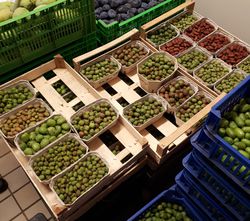 How exactly should a kiwi assortment be composed? Or more importantly and more precisely: which kiwi plants are really in demand by hobby gardeners? In this article we try to answer this question more accurately based on actual consumer demand.
How exactly should a kiwi assortment be composed? Or more importantly and more precisely: which kiwi plants are really in demand by hobby gardeners? In this article we try to answer this question more accurately based on actual consumer demand.
The problem: young plant companies and producers do not know their end consumers...
We as a young plant company, but also most of our clients, the plant producers, practically do not know their end consumers. The demand we experience is not that of the end user, but at best that of our (biggest) clients, the garden centres, garden centre chains and DIY stores and their buyers. These, in turn, only meet the real and continuous demand of hobby gardeners to a limited extent, because in many cases they only offer a limited assortment and this only during certain periods of the year. In addition, the berry collection assortments in March and April have a significant, if not dominant, influence in terms of quantity – they are simply sold off in the end and their composition is controlled more by intuition and feeling than by effective market figures...
Despite this uncertain situation and despite the great importance of the resellers or retailers (who ultimately determine the supply), it would certainly be desirable to adjust the offers at the point of sale as close as possible to the effective customer demand.
The solution: evaluation of sales data from Lubera.com
Of course, we at Lubera Edibles can't work magic either – and we currently don't have the means to conduct a comprehensive customer survey on kiwi plants. But we do have the online plant seller Lubera.com in our group of companies. Lubera.com offers a wide and comprehensive kiwi assortment 12 months a year. The sales figures and the ratio of the sales figures of different kiwi varieties and species should actually give a good picture of the effective demand. This can also help us at Lubera Edibles and our clients, the plant producers, to adjust the supply closer to the natural demand.
Of course, the objection of the plant producers is more than justified that their customers are not the end consumers but the buyers of the retailers. But our small study on the natural kiwi demand offers specifically here the opportunity to point out to the negotiating partner any deviating demands and to provide them with new ideas. Once again: the tendency is to sell better if the supply corresponds more precisely to the demand.
The basis: the statistical information from Lubera.com
Lubera.com sells between 6,000 and 10,000 kiwi plants to end consumers per year. In order for the annual influence not to be too strong and so that a short unavailability of a variety does not have too strong an effect, we have combined the figures from 2021 and 2022.
It should also be noted that Lubera.com sells kiwis exclusively in 5 litre square pots, i.e. it does not offer smaller plants in 2 litre or 3 litre or even smaller pots. But in the end, the consumer who buys a kiwi plant does not really want to buy a plant, but wants to harvest fruit in the end. It can therefore be assumed that the demand for small plants is divided similarly to that for the larger plants.
The demand ratio of classic kiwi vs. mini kiwi vs. summer kiwi (A. kolomikta)
Basically, and based on our experience (which is limited, as I said, because we have no contact with the end consumer), we would assume that the classic kiwis are significantly more popular than the mini kiwis. We see large-fruited kiwis in the supermarket every week and throughout the year we see them in our mind's eye when we think of kiwis. However, the following graph shows the ratio of the natural demand for the kiwi groups:
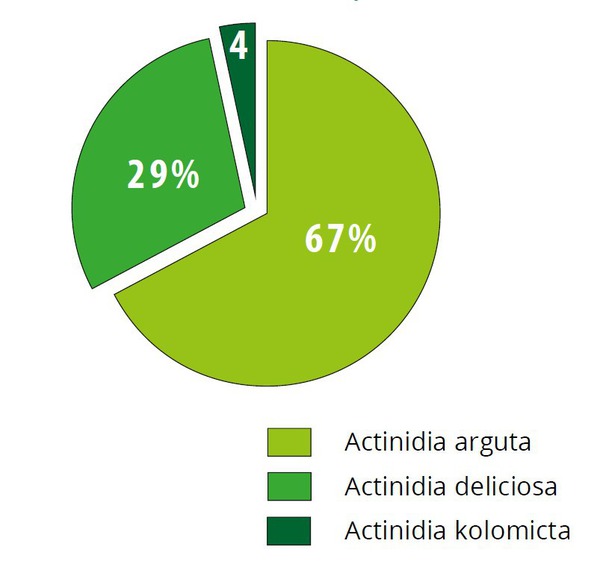
Picture: Sales broken down by Actinidia species sold
Oops, our hunch was obviously wrong. Lubera sells about twice as many mini kiwis to end consumers as classic kiwis. The summer kiwi, the fruit-bearing Actinidia kolomikta, which ripens as early as August, has so far been largely insignificant. But the mini kiwis, with their better winter hardiness, with the beautiful, directly edible fruits and with their diversity, have quite obviously succeeded in conquering a larger place in the plant horizon of hobby gardeners.
According to the natural demand reflected in these figures, twice as many mini kiwis as classic kiwis should be offered. But this would also require a wider range. A female variety, a male variety and a self-fertile variety are not enough...
How is demand distributed among the classic kiwis?
Let's now take a closer look at the classic, large-fruited but fuzzy kiwis:
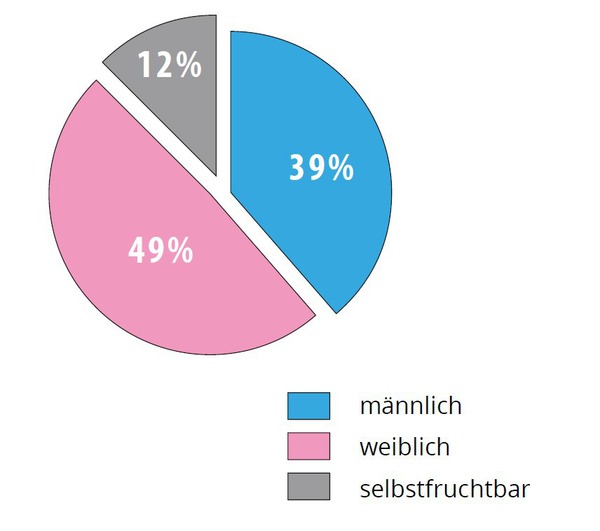
Picture: Sales of the classic/fuzzy kiwi (Actinidia deliciosa), broken down by gender of the varieties sold.
The relative insignificance of the self-fertile kiwi is striking. However, this could also be due to the fact that Lubera.com explicitly points out that the kiwi pairs perform much better and more reliably than the self-fertile varieties, which ultimately depend on successful fruit set without fertilisation (parthenocarpy). But even with this restriction, the evaluation shows that with the help of the information provided at the point of sale, it would be very possible to steer the purchase of classic kiwi fruit more towards the purchase of a pair of plants. After all, we are selling two plants instead of just one.
The ratio of female to male is not very far from 1:1. Probably because of the space requirements of a classic kiwi plant, it is not possible here to sell more female plants to one male. This could possibly be improved with the help of a more differentiated offer of different, large-fruited, classic kiwi varieties, which must, however, have a clear and also well communicable USP (early maturing, hardier, compact growing).
How is the demand distributed among the mini kiwi/grape kiwi plants?
Again, here is a reminder of the first graph: we sell twice as many Arguta as Deliciosa at Lubera.com, although we offer both species continuously and do not play them off against each other. Of course, we mention Arguta's very good absolute winter hardiness, the relatively early ripening period and also the quick onset of yield after two years (compared to three or four years for Deliciosa). But what is the distribution of sales of the mini kiwis themselves?
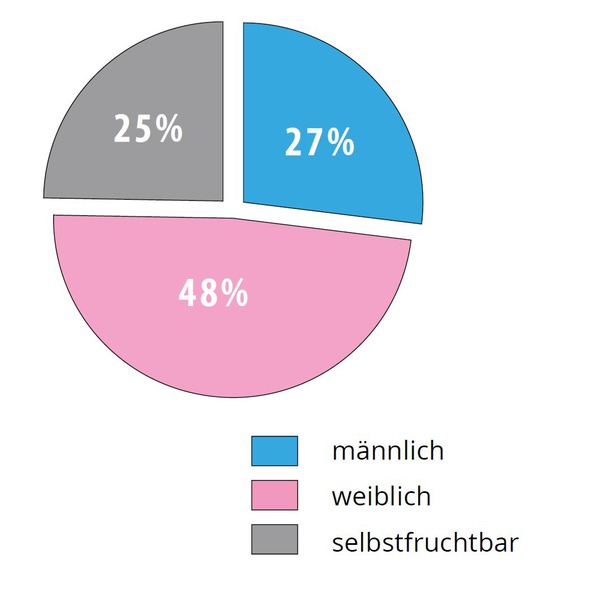
Picture: Sales of the mini kiwi or kiwi berry (Actinidia arguta), broken down by gender of the varieties sold.
Obviously, the self-fertile varieties (‘Super Issai’ in particular) are more popular and account for a quarter of the demand. But the ratio of male and female kiwi varieties sold is also interesting: here it is not 1:1 as with the large-fruited kiwis, but 1:2. It is obviously possible to sell more female kiwis to one male, mathematically and on average about two. So with the mini kiwis – if you exclude the self-fertile kiwis for a moment – three plants are usually put in the shopping basket, which should once again increase interest in this plant category.
The fact that this is possible is certainly due to the fact that we at Lubera.com can offer a very diverse range of mini kiwis, which may even be too large. It is crucial that in a diversified mini kiwi offer the USP, the points of differentiation, are identified as clearly as possible. The more such main arguments are clearly linked to individual varieties, the more plants can be sold. Many customers are also collectors; they want to have everything if there are clear advantages associated with it: the earliest ripening variety, the largest variety, the most compact growing variety, at best a new flesh colour, the best taste, etc. At the same time, it must be shown how to keep the space requirements of a grape kiwi fruit variety small (stake cultivation).
The following graph shows the ratio of green-fleshed and red-fleshed mini kiwi varieties sold, which is probably the most important distinction in the assortment.
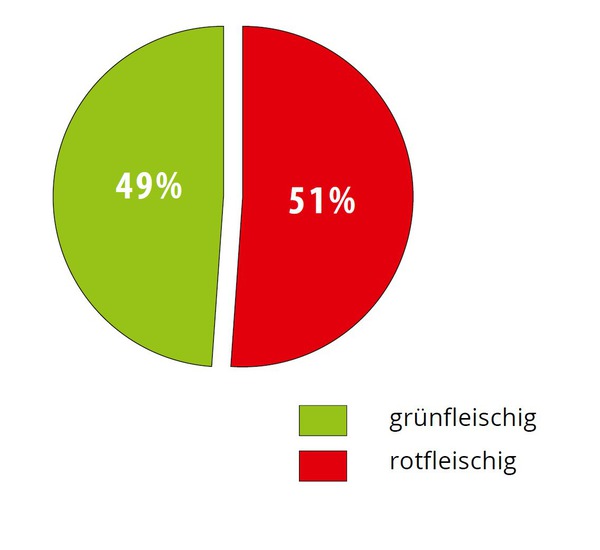
Picture: Sales of the mini kiwi or kiwi berry (Actinidia arguta), broken down by fruit colour of the varieties sold.
The ratio of red to green is 1:1, which means in practice that at least one red-fleshed and one green-fleshed variety must always be offered in a mini kiwi assortment, and that this colour difference must also be clearly shown on the label. It may be possible to expand sales even further by highlighting additional arguments and USPs of individual varieties, as we have already touched on above.
Conclusions: what does this mean for assortment planning?
Ultimately, we can draw the following conclusions from the evaluation of the Lubera.com sales. These in turn can be used both for the design of one's own assortment, but above all for discussions with plant resellers and buyers:
- More mini kiwis are in demand than classic kiwis.
- With classic kiwis, the sale of self-fertile varieties does not work very well; apparently bad experiences have spread here.
- Conversely, there is a chance to sell more female varieties of classic kiwi if they offer clear USPs that differentiate them from ‘Hayward’.
- The self-fertile varieties in the mini kiwis work well, at least better than in the large-fruited kiwis.
- Nevertheless, significantly more females/males are sold. Moreover, here it is possible to sell an average of three plants. Why shouldn't consumers plant two female mini kiwis if they already have a pollinator plant?
- For the successful sale of mini kiwi, it is crucial that the assortment offers clear USPs that encourage the hobby gardener to sell several plants. The most important USP is certainly red-fleshed vs. green-fleshed. But additional USPs are conceivable and can also be linked to suitable plants such as early harvest, large fruits, taste, etc.
